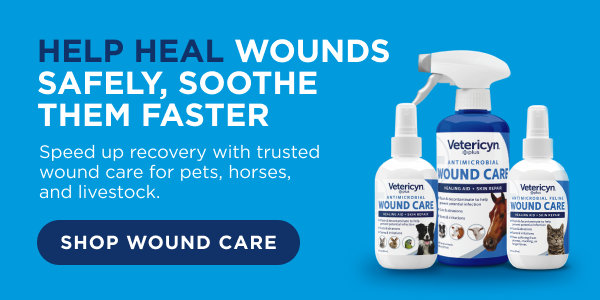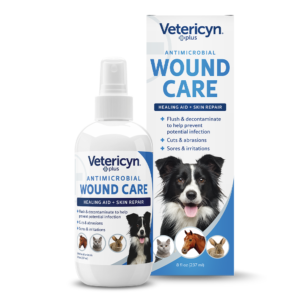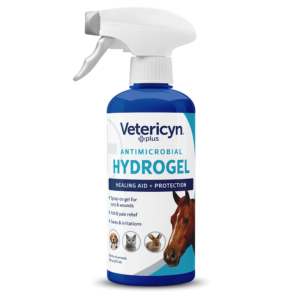Updated March 19, 2025
Let’s say your pup gets into trouble and sustains a serious wound. Thankfully, the veterinarian can fix them right up, and voila! Good as new, right?
Not so fast. It’ll take some time and diligent wound care at home before your dog’s injury is fully healed and back to normal. It’s a big ask, but we’ll help you every step of the way.
We’ll break it down and explain the four major dog wound healing stages, including potential warning signs, and how you can promote complete healing at home.
The Healing Stages of a Dog Wound
There are four healing stages for any wound.1 (dog or human):
- Inflammation
- Debridement
- Repair
- Maturation
Stage 1 – Inflammation
Inflammation happens immediately. During this phase, the body shrinks local blood vessels to minimize blood loss from the injured area and activates the immune system to attack bacteria and dead tissue.2 Signs of inflammation are swelling, pain, redness, heat, and immobility/loss of function.
If any of these symptoms seem particularly bad, or if you notice excessive bleeding, streaks around the wound, white or yellow discharge, or a nasty odor, call your veterinarian for an appointment ASAP.
Inflammation is an integral part of the healing process. As the wound progresses, swelling should subside after about a week.
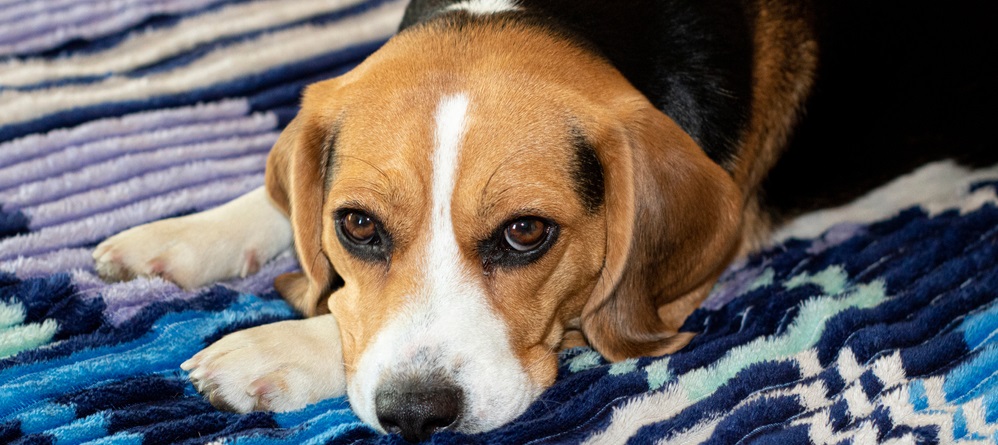
Stage 2 – Debridement
Inflammation recruits immune system cells to the wound, and during debridement, those cells act like a cleanup crew. They sweep through to the wound, removing dead tissue, debris, bacteria, and other material. Pus, white or yellow fluid from the wound, carries the debris away.2
Debridement begins within a few hours. It is either selective, meaning healthy tissue isn’t damaged, or non-selective, meaning healthy tissues get damaged.
Debridement can happen naturally (the best-case scenario) or be done manually. In autolytic, i.e., natural debridement, white blood cells soften and break down damaged tissues into liquid. It’s a sign of good healing. It also spares healthy tissues. Your veterinarian can surgically debride the wound, removing damaged or unhealthy tissues. It only targets unhealthy tissue but isn’t as precise as autolysis.
If you notice the wound smells bad, seems extra bloody or oozy, or has dry, black areas, or if your dog seems inactive or has other symptoms, make an appointment with your veterinarian. Additional treatment, including surgical debridement or other treatments, may be needed. Early intervention by a vet can ensure a quicker recovery.
Stage 3 – Repair
During this stage, the process of rebuilding begins. It starts within a few days but may take weeks to complete, depending on the size and location of the wound. Re-establishing healthy tissue in the wounded area is key to healing.2
If the wound is healing well and there is no infection, the cells will naturally begin to grow and rebuild the damaged tissues. New blood vessels grow, bringing cells that help close the wound from the edges toward the center. This new tissue is called granulation tissue.2
Based on the nature of the original injury, two wound closure processes may occur during the repair phase.1 Primary intention repair is how a wound created by surgery, for example, after a spay, heals. The skin on either side of the incision will grow together, fusing the two halves and closing the incision.2
Secondary Intention repair occurs when the wound cannot be closed with surgery because it’s too wide to bring the edges together or too infected to close. For example, bite wounds and other injuries where much skin is lost undergo secondary intention healing. These more extensive wounds heal by building up layer after layer of new tissue from the bottom up, filling the wound, pulling the edges closer, and finally laying down new, healthy skin cells. This fresh, new skin looks bright red or pink, is moist, and will bleed easily—but it is a beautiful thing to see because it’s another good sign of your dog’s healing.2
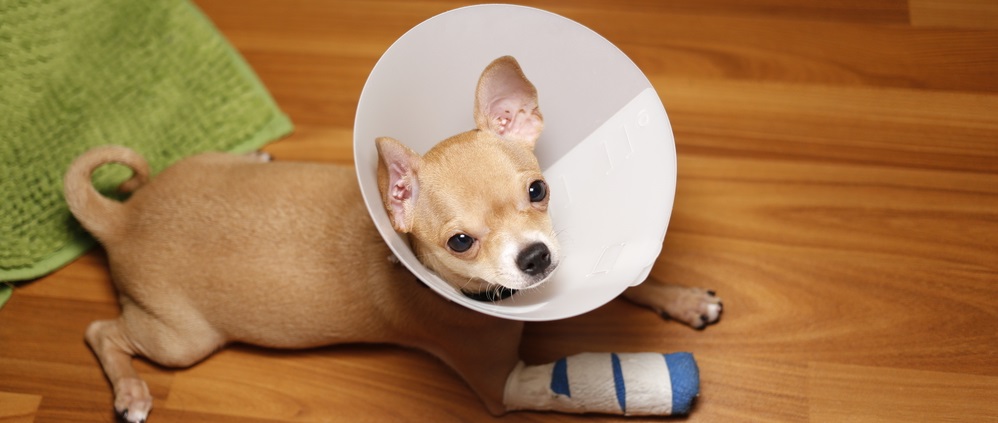
Managing Wounds at Home
Whether you’re nursing a small scratch or continuing care for a larger wound at home after the veterinarian started the healing process, your job now is to protect the new skin by keeping the area moist and clean.
1. Keep it Clean
Use a non-toxic antimicrobial cleaning spray three or four times daily to keep the wound clean and moist. Vetericyn Plus® offers a uniquely pioneered technology that replicates and enhances your dog’s self-healing mechanisms using a naturally produced hypochlorous molecule. This helps remove dirt, hair, blood, and pus, prevent infection, and promote healing. Don’t let your dog scratch, bite, lick, or contact the healing wound.
2. Comfortable, Moist, and Protected
After cleaning the wound, apply a cooling, protective layer of Vetericyn’s antimicrobial hydrogel. This will prevent debris, dirt, and bacteria from entering the wound, moisten the area, and help stop pain. A moist wound has increased blood flow, which makes healing more effective.

Stage 4 – Maturation
At this point, your pet has mostly recovered and can resume its usual routine of chasing squirrels, playing fetch, and happily barking at the wind. But that doesn’t mean their wound is completely healed. This phase starts a few weeks after the initial trauma but may take months to complete.2
Collagen, strong tissue the body brought to support wound healing, now appears lumpy and disorganized. The collagen fibers reorganize, and scar tissue gets stronger and thinner over several months to years, but it won’t be as strong as the original tissue.
Carefully monitor your dog’s activities, especially those that could affect the wounded area. For example, if the wound is on the chest or stomach, don’t let your pet play in tall underbrush, thorny plants, or anything rough they might have to climb over that could re-injure the area. A serious problem could occur, especially in the early weeks or months of recovery when the scar tissue is still weak.
Putting It to Rest
Trusted veterinary advice and well-informed at-home care are key to managing your pet’s wound. Learn more about different types of dog wounds with our expert guides.
Shop and learn with Vetericyn today!
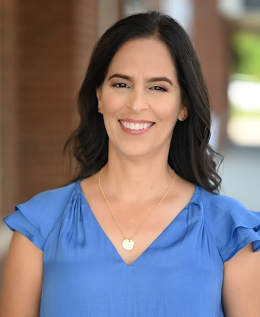 Reviewed by Dr. Kathy Adamson
Reviewed by Dr. Kathy Adamson
Dr. Kathy Adamson earned her bachelor’s degree from the University of Notre Dame and her Doctor of Veterinary Medicine degree from the University of Wisconsin-Madison School of Veterinary Medicine.
She completed a one-year small animal medicine and surgery internship at the North Carolina State College of Veterinary Medicine. Alongside her studies, Kathy worked in a research lab, contributing as an author and co-author to various journal articles.
She has also pursued medical writing and editing certification through the University of Chicago Graham School. Currently, she runs KMA Veterinary & Medical Writing, a freelance medical writing company, serves as the Digital Content Manager for the Greater Chicago Area Chapter of the American Medical Writers Association, is a member of the AMWA Communications Committee, and enjoys writing about healthcare topics for people and their cherished pets.
![]() https://www.linkedin.com/in/kathyadamsondvm/
https://www.linkedin.com/in/kathyadamsondvm/
Sources:
- Walker Smith N. Wound Healing. Veterinary Information Network. Updated 2024. Accessed February 25, 2025. https://www.vin.com/members/cms/project/defaultadv1.aspx?pid=49&id=3783415#top
- Brooks W. Wound Healing in Dogs and Cats Veterinary Information Network. Updated 2023. Accessed February 25, 2025. https://veterinarypartner.vin.com/default.aspx?pid=19239&id=6028962
